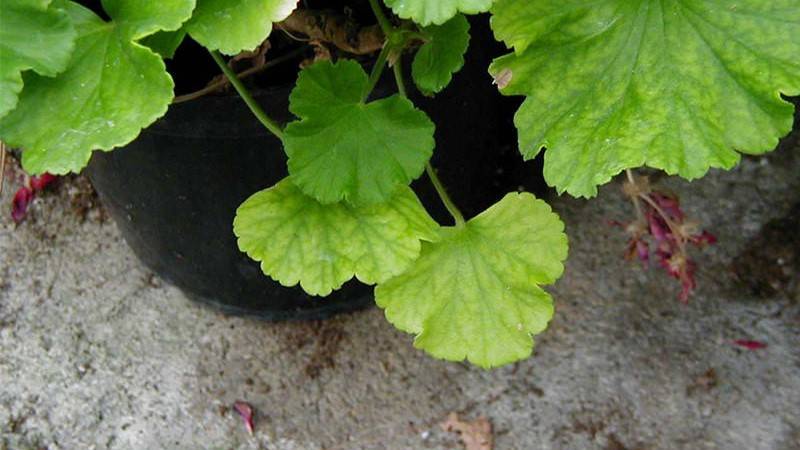Magnesium deficiency symptoms on the lower leaves of a zonal geranium. Source: Premier Tech.
Magnesium is a macronutrient that is necessary for both plant growth and health. It is involved in several different processes, including photosynthesis, which nearly all living organisms are dependent on.
Magnesium (Mg), along with calcium and sulfur, is one of the three secondary nutrients required by plants for normal, healthy growth. Don’t be confused by the term "secondary" as it refers to the quantity and not the importance of a nutrient. A lack of a secondary nutrient is just as detrimental to plant growth as a deficiency of any one of the three primary nutrients (nitrogen, phosphorus and potassium) or a deficiency of micronutrients (iron, manganese, boron, zinc, copper and molybdenum). Furthermore, in some plants, the tissue concentration of magnesium is comparable to that of phosphorus, a primary nutrient.
Function of magnesium
Many enzymes in plant cells require magnesium to perform properly. However, the most important role of magnesium is as the central atom in the chlorophyll molecule. Chlorophyll is the pigment that gives plants their green color and carries out the process of photosynthesis. It also aids in the activation of many plant enzymes needed for growth and contributes to protein synthesis.
Deficiency
Magnesium is mobile within the plant so deficiency symptoms appear first in older leaves. The symptoms show up as yellow leaves with green veins (i.e. interveinal chlorosis). Magnesium availability is not significantly affected by the pH of a soilless growing medium. However, it does become more available for plant uptake as the pH of the growing medium increases. Magnesium deficiency often is caused by lack of application, but it can be induced if there are high levels of calcium, potassium or sodium in the growing medium.
Toxicity
Magnesium toxicity is very rare in greenhouse and nursery crops. High levels of magnesium can compete with plant uptake of calcium or potassium and can cause deficiencies in plant tissue.
Where to Find magnesium
Magnesium can be found in the dolomitic limestone used in most soilless growing media, but it is usually not in sufficient supply to meet the needs of plants. Water can be a source of an appreciable level of magnesium; therefore, have it tested before choosing a fertilizer. If your water does not provide at least 25 ppm of magnesium, then it will need to be provided by fertilizer. Check the labels of the fertilizers you currently use, to see if they supply magnesium. If they do not, supplement with Epsom salts, chemically known as magnesium sulfate heptahydrate (MgSO4.7H2O). Another option is to use a cal-mag (calcium-magnesium-containing) fertilizer, but unlike Epsom salts, cal-mag fertilizers are potentially basic and will cause the growing medium's pH to rise over time.
